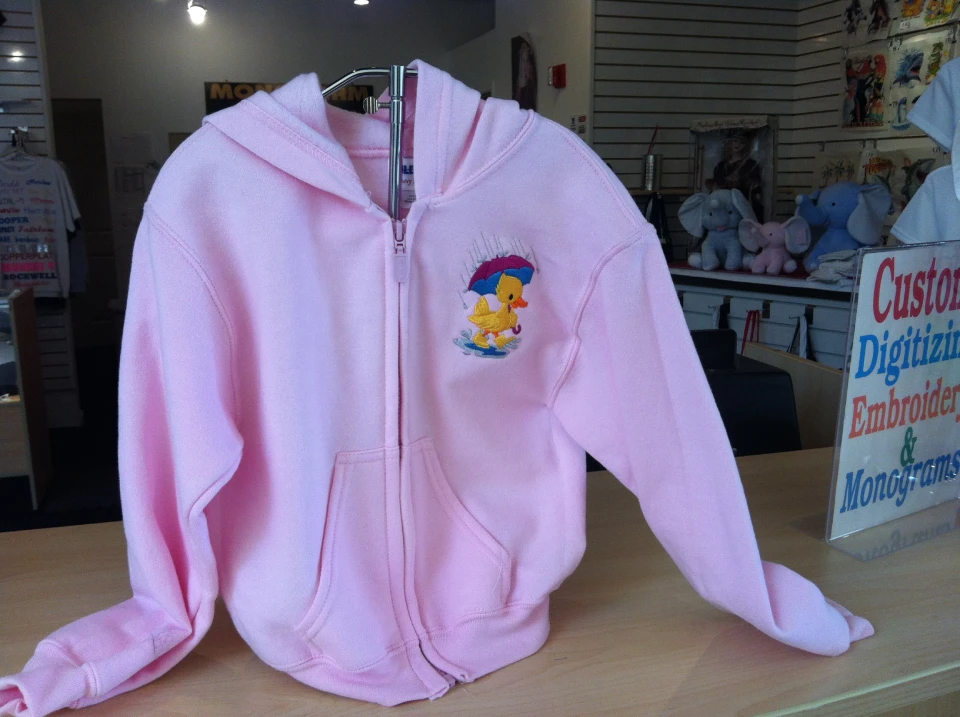The Art of Custom-made Embroidery: Opening the Tricks to Creating Unique and Remarkable Styles
Embroidery, a craft steeped in practice and artistry, holds within its complex stitches the power to change material right into a canvas of unique expression. The tricks to developing custom-made embroidery styles that astound the eye and leave a lasting perception hinge on a delicate equilibrium of technique, imagination, and interest to information. As we look into the world of custom-made embroidery, we discover the nuanced interaction in between string selection, stitch complexity, and layout personalization that raises a plain garment to a masterpiece. Join us on a trip via the art of custom embroidery as we unwind the enigmas behind crafting absolutely unforgettable and distinctive developments.
Selecting the Right Needlework Threads
When choosing embroidery strings, what crucial elements should you consider to make certain the best outcomes for your custom-made designs? The selection of embroidery thread is vital in identifying the last result of your stitched design.
Additionally, the weight or density of the thread plays a considerable duty in the appearance of the needlework. Thicker strings can add measurement and structure to your layout, while finer threads are ideal for complex information and small text. In addition, considering the color fastness and washability of the thread is critical to ensure that your customized layouts maintain their top quality and vibrancy with time. By carefully reviewing these aspects and picking high-quality threads that satisfy your certain needs, you can boost the visual appeal and durability of your stitched productions.
Checking Out Different Stitch Methods
To look into the realm of 'Exploring Different Stitch Strategies', one must grasp the intricacies and subtleties that each stitching technique gives the art of embroidery. Different stitch techniques not just include aesthetic rate of interest however also add to the overall texture and dimension of the design. One popular stitch strategy is the satin stitch, which entails very closely stuffed parallel stitches to develop a smooth and glossy surface area, perfect for loading in forms and creating bold outlines.
On the various other hand, the backstitch is a versatile strategy often made use of for laying out and including great details. It includes stitching in reverse to develop a strong line of embroidery. Additionally, the French knot stitch adds a responsive component to styles, ideal for creating distinctive accents like blossom centers or decorative touches.
Discovering different stitch methods permits embroiderers to play with light, shadow, and deepness within their styles, elevating the aesthetic appeal and imaginative high quality of their needlework jobs. By mastering numerous stitching approaches, one can open unlimited opportunities for developing distinct and memorable custom needlework pieces.
Incorporating Personalized Layout Aspects
Having actually explored the ins and outs of different stitch strategies such as the satin stitch, backstitch, and French knot, the focus currently changes towards incorporating customized layout elements in customized needlework tasks. Customized layout components play an essential function in making needlework tasks absolutely unique and memorable.
One more way to integrate customized design components is by consisting of symbols or themes that hold unique definition his comment is here to the recipient or mirror their interests and character. As an example, including a favored blossom, pet, or hobby-related icon can make the needlework layout more meaningful and individualized. Additionally, choosing colors that resonate with the recipient or align with the intended theme can further enhance the customization of the needlework task.
Understanding the Art of Shade Control

One secret facet of color sychronisation is recognizing shade theory. This consists of understanding how different colors communicate with each other, the emotions they communicate, and just how they can be incorporated to create visually attractive styles. By using shade look at this web-site concept concepts, embroiderers can produce unified shade combinations that improve the general appearance of the layout.
In addition, taking notice of comparison is important in shade sychronisation. Using contrasting shades can assist specific aspects of the style pop, boost clarity, and create a visually dynamic needlework item. By understanding the art of color control, embroiderers can boost their designs and develop remarkable items that resonate with clients and viewers alike.
Enhancing Texture With Advanced Needlework Stitches
French knots, for instance, are perfect for including tiny, elevated dots to your layout, resembling the appearance of grains or developing a distinctive surface area. Bullion knots, on the other hand, can be utilized to produce twisted, ropelike aspects that add an elegant feel to the embroidery. Seed sewing entails little, scattered stitches that can load in locations with a multicolor structure, while turkey work creates cosy, dimensional accents evocative pet hair or foliage. Experimenting with these advanced embroidery stitches permits you to press the limits of conventional embroidery and produce absolutely one-of-a-kind and aesthetically attractive textures in your designs.
Conclusion
Finally, the art of customized needlework entails a mix of choosing the right strings, exploring numerous stitch methods, incorporating tailored design components, grasping shade sychronisation, and improving texture with sophisticated stitches. By understanding and carrying out these crucial elements, embroiderers can produce unique and unforgettable designs that showcase their visite site creative thinking and skill. Needlework enthusiasts can open the secrets to producing gorgeous and bespoke items that stand out and leave an enduring impact.
Comments on “Heat Transfer on T-Shirts and Aprons - Custom Designs and Logo Designs”